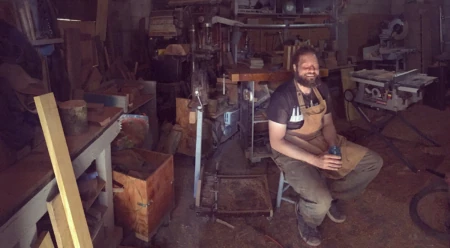Sawdust Is My Glitter: The Story of Blind Craftsman John Furniss
Editor’s note: This post discusses anxiety and suicide.
In a humble workshop in Washougal, Washington, a blind craftsman holds a locally harvested log that he has made into a blank with his miter saw. He turns it in his hands to feel its shape and weight. He measures and marks, measures and marks. A flick of the switch, an electric buzz and the lathe rumbles to life, replacing the morning stillness. He carefully bends over his work and rhythmically turns the blank. Like many great artists, he already sees the finished creation in his mind. Unlike many great artists, his creation will, for him, forever live in his mind’s eye. For John Furniss, satisfaction comes from the work itself and knowing his masterpieces will be seen and cherished by others.
Into the Labyrinth
In what seems like another lifetime to him, John was a deeply troubled teenager with major anxiety. “It caused me to feel that I was not accepted in any group,” he recalls. “It was isolating.” The isolation made him feel violent inside, which he eventually turned on himself. When he was 16 years old, he held a gun to his head and pulled the trigger. Almost seven hours later, the doctors pronounced him alive, but blind. Every year since, he’s celebrated his “life day”—the day that darkness showed him the light. He celebrated his 21st life day in April.
But the light didn’t shine brightly all at once. In the despair of reckoning with his new blindness, John turned to drugs. He thanks his friend, Blueford “Bud” Dotson, for helping him through this time. “He was about 40 years older than me,” John says. “When I was heavily into drugs in my early 20s, I could always count on Bud to give me somewhere to get away from the drugs. He always had some hot soup or stew to feed me, and we loved watching old movies together. He took care of me when I needed it most.”
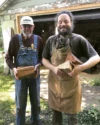
John can reflect with gratitude on friends and mentors who’ve helped him along the way. His neighbor Ralph Craig drops off some locally sourced maple, buckthorn and yew wood. Photo: Anni Furniss
Then came the long years at a vocational rehabilitation school in Utah, where he tediously learned Braille and other skills. A blind woodworking instructor, Chris Hathaway, took John under his wing and taught him how to use tools and identify different woods by touch. John had dabbled in woodworking when he had sight, but now the craft held a new meaning for him. It was a tangible challenge, and he threw himself into what would become his lifework. But his path still had a few more surprises before he would be able to make a living as an artisanal woodworker.
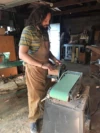
John uses his belt sander (“Colonel Sanders”) to prepare boards that he’ll glue together to make a blank. Photo: Anni Furniss
With the Grain
Hathaway told John about an opportunity to study piano rebuilding at the Emil Fries School of Piano Technology for the Blind, in Vancouver, Washington. At 29 years old, John left Utah for the Pacific Northwest. He graduated two years later and started his own piano-rebuilding business with a friend. He was happy to ply his new trade but yearned for the smell of sawdust and the vibrations of maple or black walnut turning on the lathe.
While attending the School of Piano Technology, John met a woman named Anni Becker. An accomplished artist, Anni was painting pianos as part of a fundraising project for the school. John approached her and put his hand on the piano, not knowing the paint was still wet. Their first date was spent harvesting peas under the moonlight in John’s community garden space. “Be still, my tree-hugging, dirt-worshipping heart,” she remembers telling herself as John revealed his personality and dimples. He asked if he could feel what she looked like, the best pickup line she’d ever heard. Three years after what they like to call their “blind date,” they were married under the moonlight in the same pea patch.
Anni bought John his first lathe after listening to his desire to go back to his true calling: woodworking. He quit the piano-rebuilding job to devote his time to crafting wooden bowls, plates, mortar and pestles, trays and smartphone amphitheaters, which he sells online and at various local craft events and retail spaces. Along with continuing her painting career, Anni helps John run the social media and technology side of their business, Furniss Studios. She files his paperwork, helps with money transactions and organizes his woods by color. “I couldn’t do what I do without the love and support of my wife,” John says. “I have grown as a person through our relationship more than any other time in my life.”

“In anything at all,” to quote Antoine de Saint-Exupéry, “perfection is finally attained not when there is no longer anything to add, but when there is no longer anything to take away.” Bowl made from padauk and yellowheart wood. Photo: Anni Furniss
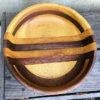
To craft this walnut and yellowheart wood bowl, John made three 4″ x 12″ blocks and glued them together to make the blank. After letting the glue dry overnight, he shaped it on the lathe. Photo: Anni Furniss
Woodworking Without Sight: How It Gets Done
“My sense of hearing has become particularly keen,” John says. “Ninety percent of my navigation is done by sound, not by feel. When I am woodworking, that reverses. The sounds of my tools are very important, but I mostly rely on touch. I feel the wood as I am turning it on the lathe, even though this is not a recommended practice.” His best friend in the shop is his rotomatic measuring tool, a threaded piece of metal with raised grooves corresponding to the marks on a traditional tape measure, and a nut. As he turns the nut around the grooves, the clicks allow him to feel his measurements.
His advice for blind woodworkers: “Watch those fingers, baby!” Safety is first in any shop, but John takes a few extra steps to keep his digits intact, like leaving power tools unplugged until cut time and turning off the radio while he’s working.
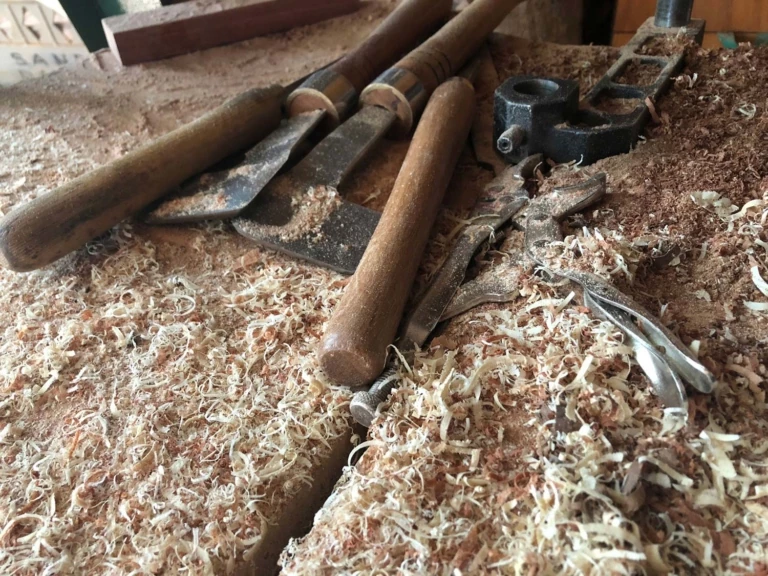
John has nicknames for his chisels, like “Big Jake” and “Carver Family.” He calls these two his “Battle Axes.” Photo: Anni Furniss
Environmentalism factors strongly into John’s work. Most of his exotic hardwoods are ethically sourced, and he also uses a lot of locally harvested wood from the Washougal area. His friends and neighbors let him know when they have wood from felled trees, often dropping it off at his shop. “All of my preservatives and finishes are food and allergen safe,” he says. “I like to use a combination of beeswax, carnauba wax and orange, lemon and mineral oils all mixed together.”
John’s fingers are so calloused from his work that he can no longer feel Braille. But he uses his Library of Congress membership to download and listen to audiobooks. John and Anni enjoy playing Jenga, hiking their favorite nature trail with their dog, brewing their own beer and baking bread. His goal is to expand beyond the lathe into things like jewelry boxes and tables and get his work into more retail spaces. His message to blind people: “Never give in. You can always find a way to do the things you want to do. Share your blindness with those around you to show that we’re not so different. Sharing your perspective with sighted people can spread awareness.”
John is passionate about sharing his story and regularly gives suicide prevention talks at schools, churches and artist gatherings. “When I reflect back on things,” he says, “I want to tell my younger self it’s not so bad. Tomorrow will come, and things can always change. Also, get help. Whether that means talking to a friend or a professional, just anyone. It’s ok to admit you need help.”
If you’re experiencing troubled thoughts or thinking of suicide, there are people who’ve been there, too and are ready to help. Here’s one place to start.
